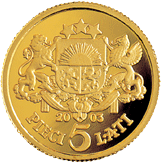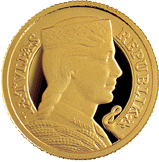

Face value: 5 lats.
Weight: 1.2442 g; diameter: 13.92 mm.
Metal: gold, fineness 9999; quality: proof.
Struck in 2003 by Valcambi SA (Switzerland).
The design of the coin was created by Gunars Cilitis (design based on Rihards
Zarins' drawing for the silver 5-lats coin struck in 1929, 1931 and 1932) and
the plaster cast was modelled by Ligita Franckevica.
Obverse
The large coat of arms of the Republic of Latvia is placed in the centre. The
numeral 5 topped with the year 2003 are inscribed beneath the central motif. The
inscriptions PIECI and LATS, arranged in a semicircle, are placed to the left
and right of the central motif, respectively.
Reverse
The central motif is a Latvian maiden in profile, viewed from the right side.
The girl has ears of corn on her shoulder. The inscriptions LATVIJAS and
REPUBLIKA, arranged in a semicircle, are placed to the left and right of the
central motif, respectively.
Edge
Reeded.
One of the most beautiful Latvian folk-song images is the folk-maid, the symbol
of virtue and righteousness that seem to cast ever radiant light upon her work
and the world around her.
After World War I, when Latvia had
become an independent state with its own national currency, among the authors of
the new lats coins was the graphic artist Rihards Zariņš (1869-1939), manager
of the State Securities Printing House. For the obverse of the 5-lats silver
coin he chose his 1921 design of the large coat of arms of the Republic of
Latvia, which was created on the basis of the draft design of the State coat of
arms, made by the graphic artist Vilhelms Krūmiņš; on the reverse he depicted
a Latvian folk-maid.
The prototype of the Latvian folk-maid
was Zelma Brauere (1900-1977), a proofreader of the State Securities Printing
House, whose youth, beauty and gentle demeanor fascinated the artist. Various
images of Zelma Brauere can be also recognized on the 10-lats and 20-lats bank
notes designed by Rihards Zariņš, as well as on the covers of expensive
telegrams and, somewhat generalized, on the 50-santims coin.
On the reverse of the 5-lats coin,
Rihards Zariņš has portrayed a girl in profile, viewed from the right side.
Scarce means have been used to typify the image: ears of corn on the girl's
shoulder, a rich braid on her back, her collar and head-dress embroidered with
an ornamental design characteristic of Latvian folk costume. The artistic
expression is intensified by the serene beauty of mutual relationship and the
simultaneous lightness and firmness of the silhouette.
Before World War II, the 5-lats coin
became popular in a short time, and, like the statue that tops the Freedom
Monument, obtained a symbolic meaning. People gave 5-lats silver coins to their
children as gifts; they stored and kept them "for a rainy day" -
as if they had some apprehension, some foreboding.
At the time of World War II,
occupations followed one another; the Latvian state lost its independence and
national currency. The 5-lats silver coin had a destiny unlike, perhaps, any
other coin of the world - it became a symbol of Latvian freedom and sovereignty,
a ray of hope, secretly stored by almost every family who lived in the occupied
Latvia, was deported to Siberia, or went into exile, scattered over the whole
world.
The coin survived in another form as
well. Transformed into a brooch, it became a mute confirmation of the Latvian
identity and the belief of Latvians in regaining their independence. It was a
quiet, but obvious defiance to the occupant rule, which acquired a special
meaning in late 1980s, the beginning of the national awakening movement.
The Bank of Latvia has issued the gold
coin to commemorate the tenth anniversary of restoration of the Latvian national
currency, preserving the 5-lats silver coin's historic symbols of wealth and
freedom of the people.